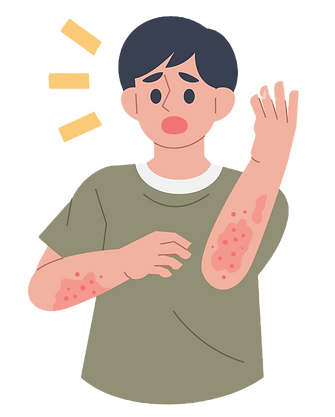
What are Ignored Symptoms?
Often overlooked cancer symptoms can be subtle yet significant indicators of underlying issues. Symptoms like persistent indigestion, unexplained night sweats, recurring fevers, unexplained bleeding, persistent hoarseness, or a nagging headache that doesn’t go away can easily be dismissed or attributed to less serious health concerns. However, these signs should not be ignored as they can sometimes point to early stages of cancer. Awareness and attention to such persistent and unusual symptoms are key in pursuing timely medical consultation and potentially early diagnosis.
"Early Signs, Early Solutions: Be Symptom-Aware"
01
Persistent Night Sweats
Persistent night sweats, although often dismissed as a nuisance or a result of environmental factors such as room temperature or bedding, can be significant symptoms that should not be ignored, particularly when they occur regularly without an obvious cause. While occasional night sweats may occur due to stress, hormonal changes, or certain medications, persistent night sweats can sometimes indicate underlying health issues, including infections, hormonal imbalances, or even cancer.
-
Frequency and Severity: Persistent night sweats occur frequently, often several times a week, and can be severe enough to disrupt sleep and affect overall quality of life.
-
Duration: These night sweats persist for an extended period, typically lasting for more than a month, and may occur despite attempts to address potential triggers such as room temperature or bedding.

-
Night sweats that are accompanied by other symptoms such as fever, unexplained weight loss, fatigue, or swollen lymph nodes.
While occasional night sweats are usually harmless, persistent night sweats should not be ignored, as they may indicate an underlying health issue that requires medical attention. Ignoring persistent night sweats could delay diagnosis and treatment of potentially serious conditions, including infections or cancer.
If you experience persistent night sweats, it's essential to consult a healthcare provider for evaluation and appropriate management. Your healthcare provider may conduct a thorough medical history, physical examination, and diagnostic tests to determine the underlying cause of your symptoms.
Early detection and treatment are crucial for improving outcomes and reducing the risk of complications associated with underlying health conditions. Remember, timely medical evaluation and intervention can help identify and address potential health concerns, including infections or cancer, and improve your overall health and well-being.

Unexplained Anemia
Unexplained anemia, characterized by a lower-than-normal level of red blood cells or hemoglobin in the blood, is a symptom that warrants medical attention, particularly when it occurs without an obvious cause such as blood loss or nutritional deficiencies. While anemia can occur for various reasons, including iron deficiency, vitamin B12 deficiency, or chronic diseases, unexplained anemia may indicate underlying health issues, including gastrointestinal bleeding, bone marrow disorders, or even cancer.
02
-
Frequency and Severity: Unexplained anemia persists despite efforts to address potential causes such as dietary changes or iron supplementation.
-
Duration: The individual does not have known risk factors for anemia, such as heavy menstrual bleeding, gastrointestinal bleeding, or a history of chronic diseases.
-
Anemia that is accompanied by other symptoms such as fatigue, weakness, shortness of breath, pale skin, or dizziness.
Early detection and treatment are crucial for improving outcomes and reducing the risk of complications associated with underlying health conditions. Remember, timely medical evaluation and intervention can help identify and address potential health concerns, including gastrointestinal bleeding or cancer, and improve your overall health and well-being.
03
Chronic headaches
Chronic headaches, defined as headaches occurring on 15 or more days per month for at least three months, can significantly impact quality of life and may indicate underlying health issues beyond occasional stress or tension. While occasional headaches are common, persistent or chronic headaches that interfere with daily activities should not be ignored, as they may be indicative of underlying health conditions, including migraines, tension-type headaches, or even serious neurological disorders.

-
Frequency and Severity: Chronic headaches occur on a frequent basis, often more than 15 days per month, and can last for several hours or even days at a time.
-
Intensity and Severity: Chronic headaches may vary in intensity, ranging from mild discomfort to severe pain, and may be accompanied by other symptoms such as nausea, sensitivity to light or sound, or visual disturbances.
-
Headaches that are accompanied by other concerning symptoms such as changes in vision, speech difficulties, weakness, numbness, or difficulty walking.
If you experience chronic headaches, it's essential to consult a healthcare provider for evaluation and appropriate management. Your healthcare provider may conduct a thorough medical history, physical examination, and diagnostic tests, including imaging studies (such as MRI or CT scans) or neurological evaluations, to determine the underlying cause of your headaches.
Early detection and treatment are crucial for improving outcomes and reducing the risk of complications associated with underlying health conditions. Remember, timely medical evaluation and intervention can help identify and address potential health concerns, including migraines or neurological disorders, and improve your overall health and well-being.

Sudden Vision or Hearing Changes
Sudden vision or hearing changes are significant symptoms that should never be ignored. They can indicate underlying health issues that require prompt medical attention. While occasional changes in vision or hearing might occur due to temporary factors such as fatigue or stress, sudden and persistent changes should be taken seriously as they can affect daily activities and quality of life.
Sudden Vision Changes:
1. Blurred Vision: Abrupt blurring or haziness of vision, making it difficult to see objects clearly.
2. Double Vision: Seeing two images instead of one, either side by side or overlapping.
3. Flashes of Light: Sudden appearance of flashes or sparkles of light in the visual field.
4. Partial or Total Loss of Vision: Sudden loss of vision in one or both eyes, either partially or completely
Sudden Hearing Changes:
1. Sudden Hearing Loss: Rapid onset of hearing loss in one or both ears, making it difficult to hear sounds clearly.
2. Ringing in the Ears (Tinnitus): Sudden onset of ringing, buzzing, or humming sounds in one or both ears, which may be constant or intermittent.
04
-
Sudden vision or hearing changes accompanied by other concerning symptoms such as headache, dizziness, nausea, vomiting, facial numbness, weakness, or difficulty speaking.
If you experience sudden vision or hearing changes, it's crucial to seek urgent medical care. Your healthcare provider will conduct a thorough evaluation, including a physical examination and possibly diagnostic tests such as imaging studies or auditory tests, to determine the cause of your symptoms.

Shortness of Breath with Minimal Effort
05
Experiencing shortness of breath with minimal effort can be a concerning symptom that warrants medical attention. While shortness of breath can occur during physical exertion or in high-stress situations, experiencing it with minimal effort, such as while resting or performing routine activities, may indicate underlying health issues, including respiratory, cardiovascular, or other medical conditions.
-
Difficulty Breathing: Feeling as though you cannot get enough air or feeling breathless even when you're not exerting yourself.
-
Rapid Breathing: Breathing faster than usual, even without physical activity or exertion.
-
Shallow Breathing: Taking quick, shallow breaths instead of deep, full breaths, which may not provide enough oxygen to the body.
-
Shortness of breath that is accompanied by other concerning symptoms such as chest pain, dizziness, lightheadedness, fainting, coughing, wheezing, or swelling in the legs or ankles.
Early detection and treatment are essential for managing underlying health conditions and preventing complications associated with shortness of breath. Remember, timely medical evaluation and intervention can help identify and address potential health concerns, ensuring your overall health and well-being.
Frequent Infections
Experiencing frequent infections can be a sign of an underlying health issue, particularly if they occur more often than usual or take longer to resolve. While occasional infections are a normal part of life and can often be fought off by a healthy immune system, recurrent or persistent infections may indicate an immune system dysfunction or other medical conditions.
06

-
Frequency: Having infections more frequently than usual, such as multiple respiratory infections (e.g., colds, sinus infections), urinary tract infections, skin infections (e.g., cellulitis), or gastrointestinal infections within a short period.
-
Severity: Experiencing infections that are more severe or take longer to resolve than typical, requiring multiple courses of antibiotics or medical intervention.
-
Conditions such as immune system disorders (e.g., HIV/AIDS, primary immunodeficiency disorders), diabetes, chronic lung diseases (e.g., bronchiectasis), autoimmune diseases, or certain cancers (e.g., leukemia, lymphoma) may weaken the immune system and increase the risk of frequent infections.
If you experience frequent infections, it's essential to consult a healthcare provider for evaluation and appropriate management. Your healthcare provider may conduct a thorough assessment, including a review of your medical history, physical examination, and possibly diagnostic tests such as blood tests, imaging studies, or immune system evaluations to determine the underlying cause of your recurrent infections.
Early detection and treatment are crucial for managing underlying health conditions and reducing the risk of complications associated with frequent infections. Remember, timely medical evaluation and intervention can help identify and address potential health concerns, ensuring your overall health and well-being.

Loss of Appetite or Unexplained Satiety
Experiencing a loss of appetite or unexplained satiety, where you feel full despite eating very little, can be concerning symptoms that may indicate underlying health issues. While occasional changes in appetite are normal and can occur due to factors like stress or temporary illness, persistent loss of appetite or unexplained feelings of fullness may signal underlying medical conditions that require attention.
07
-
Loss of Appetite: A decrease in desire to eat, leading to reduced food intake over time. This can result in unintentional weight loss and nutritional deficiencies if not addressed.
-
Unexplained Satiety: Feeling full or satisfied after eating very little food, even if you haven't eaten a substantial meal. This sensation may persist for an extended period, making it difficult to consume adequate nutrients.
-
Conditions such as gastrointestinal disorders (e.g., gastritis, peptic ulcers, gastroesophageal reflux disease), hormonal imbalances (e.g., thyroid disorders, diabetes), mental health disorders (e.g., depression, anxiety), or certain cancers (e.g., stomach cancer, pancreatic cancer) may cause changes in appetite.
If you experience loss of appetite or unexplained satiety, it's essential to consult a healthcare provider for evaluation and appropriate management. Your healthcare provider may conduct a thorough assessment, including a review of your medical history, physical examination, and possibly diagnostic tests such as blood tests, imaging studies, or gastrointestinal evaluations to determine the underlying cause of your symptoms.
Early detection and treatment are crucial for managing underlying health conditions and preventing complications associated with changes in appetite. Remember, timely medical evaluation and intervention can help identify and address potential health concerns, ensuring your overall health and well-being.

Numbness or Weakness in Limbs
Experiencing numbness or weakness in the limbs can be a concerning symptom that may indicate underlying health issues. While occasional numbness or weakness may occur due to temporary factors like pressure on nerves or muscle fatigue, persistent or recurrent symptoms should be evaluated by a healthcare professional as they could be signs of various disorders.
08
-
Numbness: A loss of sensation or tingling sensation in one or more limbs, often described as a "pins and needles" feeling. Numbness may occur in specific areas or spread throughout the limb.
-
Weakness: Reduced strength or ability to move one or more limbs, making tasks such as lifting, gripping, or walking difficult. Weakness may be temporary or persistent and may affect one side of the body more than the other.
-
Conditions such as nerve compression (e.g., carpal tunnel syndrome), peripheral neuropathy, stroke, multiple sclerosis, spinal cord injury, herniated disc, or muscular disorders (e.g., muscular dystrophy) may cause numbness or weakness in the limbs.
If you experience numbness or weakness in the limbs, it's essential to seek medical evaluation promptly. Your healthcare provider will conduct a thorough assessment, which may include a physical examination, neurological tests, imaging studies (e.g., MRI, CT scan), or nerve conduction studies to determine the underlying cause of your symptoms.
Early detection and treatment are crucial for managing underlying health conditions and preventing complications associated with numbness or weakness in the limbs. Remember, timely medical evaluation and intervention can help identify and address potential health concerns, ensuring your overall health and well-being.

Persistent Itching or Skin Irritation
09
Persistent itching or skin irritation can be bothersome symptoms that may indicate underlying skin conditions or other health issues. While occasional itching or irritation can occur due to dry skin, insect bites, or allergic reactions, persistent or recurrent symptoms should be evaluated by a healthcare professional as they could be signs of dermatological disorders, allergies, or systemic diseases.
-
Persistent Itching: Continuous or recurrent sensation that prompts scratching or rubbing of the skin, often without relief. Itching may occur in specific areas or affect large areas of the body.
-
Skin Irritation: Redness, inflammation, or discomfort of the skin, which may be accompanied by itching, burning, or stinging sensations. Skin irritation may be localized or widespread and can result from various factors such as contact with irritants or allergens.
-
Conditions such as eczema (atopic dermatitis), psoriasis, allergic dermatitis, fungal infections (e.g., ringworm), scabies, or hives (urticaria) may cause persistent itching or skin irritation.
If you experience persistent itching or skin irritation, it's essential to seek medical evaluation promptly. Your healthcare provider will conduct a thorough assessment, which may include a physical examination, review of medical history, allergy testing, skin biopsy, or other diagnostic tests to determine the underlying cause of your symptoms.
Early detection and treatment are crucial for managing underlying skin conditions and preventing complications associated with persistent itching or skin irritation. Remember, timely medical evaluation and intervention can help identify and address potential health concerns, ensuring your overall health and well-being.

Non-healing Sores or Ulcers
Non-healing sores or ulcers are concerning symptoms that may indicate underlying health issues, particularly if they persist for an extended period or fail to respond to conventional treatments. While minor cuts or abrasions typically heal on their own within a few days, non-healing sores or ulcers may be indicative of more serious conditions such as infections, vascular disorders, or skin cancers.
10
-
Duration: Sores or ulcers that do not heal within the expected time frame, typically within a few weeks, despite appropriate wound care and treatment.
-
Size and Depth: Sores or ulcers that are deep, large, or expand over time, often with irregular borders and surrounding redness or inflammation.
-
Pain or Discomfort: Presence of pain, tenderness, or discomfort at the site of the sore or ulcer, particularly if it worsens over time or interferes with daily activities.
-
Conditions such as diabetes, peripheral artery disease (PAD), venous insufficiency, autoimmune disorders (e.g., lupus), or skin cancers (e.g., basal cell carcinoma, squamous cell carcinoma, melanoma) may cause non-healing sores or ulcers.
If you have non-healing sores or ulcers, it's essential to seek medical evaluation promptly. Your healthcare provider will conduct a thorough assessment, which may include a physical examination, review of medical history, wound culture, imaging studies (e.g., ultrasound, MRI), or biopsy to determine the underlying cause of the non-healing wound.
Early detection and treatment are crucial for managing underlying health conditions and preventing complications associated with non-healing sores or ulcers. Remember, timely medical evaluation and intervention can help identify and address potential health concerns, ensuring your overall health and well-being.


